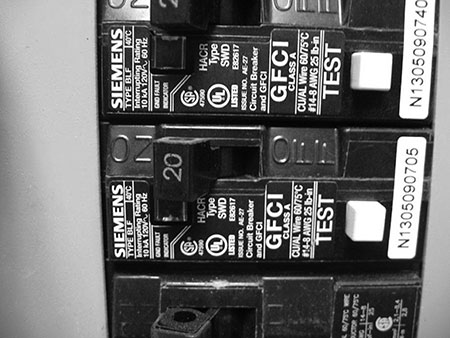The phone was ringing. Actually, both phones were ringing—desk and cell phones. It must be important. I answered the cell first and let the land line go to voicemail. My field inspector was calling about a couple of items that he had discovered while performing a final electrical inspection for a new restaurant.
Access for inspection was the first problem. None of the final inspections by the Building, Planning, Fire or Health Departments had been completed, but the restaurant staff was already stocking the facility. In my jurisdiction, we are always happy to cooperate with the tight time schedules required in the modern construction world. However, the key word is cooperate. Complete access is necessary so that we can provide a quick and accurate inspection. It is difficult to inspect the (almost) finished space with boxes in the way!

The other item of concern for the inspector was the NEC 210.8(B)(2) requirement for GFCI protection of the commercial kitchen receptacles.
Beginning with the 2002 NEC, all 15- and 20-amp, 125-volt receptacles, located in a nondwelling type kitchen are required to have GFCI protection. The requirement applies to all receptacles whether intended for general use or dedicated for a specific appliance. Application of the rule is intended for all locations within the kitchen, not just those receptacles that serve countertop areas. Accident data was provided to justify the inclusion of kitchens to NEC 210.8(B) Ground-Fault Circuit-Interrupter Protection for Personnel – Other Than Dwelling Units in 2002. Possible commercial kitchen hazards include wet floors, damaged cords, and poorly maintained equipment. Also, employees may not have the necessary electrical safety training to recognize the resulting electrical hazards. The term kitchen, previously only defined for the purposes of 210.8(B)(2), was added to NEC Article 100 Definitions in 2008 to provide for consistent application of the NEC requirements.
The project electrical engineer had specified the GFCI protection be provided by the circuit breaker for all 15 & 20 ampere branch circuits supplying, 125 volt receptacles as required by 210.8(B)(2).
The inspector had used a plug-in type GFCI tester to verify the operation of the circuit breakers. Although not recognized by the circuit breaker manufacturer as an accurate operational test, the plug-in type of tester can be useful to at least verify that the receptacle outlets are connected to the correct GFCI branch-circuit breaker. The tester cannot be relied upon to supply a precise ground-fault current to certify the operation of the protective circuitry, but the fault-current, though not precise, may cause the GFCI device to operate. The “test” button on the GFCI device (circuit breaker in this example) must be used to verify proper operation, and that is the procedure we use. There is a distinction between checking the correct operation of the individual GFCI’s protective element and verification that those devices are supplying the intended branch circuits. Do not confuse the two! The better approach would be to use the “test” button on the GFCI device to verify operation, followed up by a voltage test on all receptacles to confirm correct circuiting.
It appeared the receptacles were not protected as none of the GFCI devices operated when tested with the receptacle plug-in device. The inspector then went to the branch-circuit panelboard to verify that the GFCI circuit breakers had been installed correctly. He pushed the ground-fault “test” button on each breaker. To his surprise, all circuit breakers operated properly when tested! At that point, his assumption was that the plug-in testing device was not operational, or at least not accurate enough to verify the circuit breaker operation. Since the circuit breakers operated correctly when the “test” button was pushed, they were obviously working as intended, and the installation met the requirements of NEC 210.8(B)(2)…right?
Not necessarily. I told the inspector to take a closer look at those circuit breakers. Did they provide Class A ground-fault protection?

Circuit Breakers and Ground-Fault Circuit Interrupters (UL Product Category DKUY) will open the circuit when ground-fault current has a value in the range of 4 through 6 mA (Class A). Why that range? Because current through the human body in that range can cause muscle contraction, preventing the victim from self-release of the faulted circuit. Even worse, a current path through the heart may result in ventricular fibrillation, effectively stopping the heart from pumping blood through the body. Where ground-fault protection for personnel is specified by the NEC, Class A ground-fault protective devices must be used.

Circuit Breakers with Equipment Ground-Fault Protection (UL Product Category DIYA) will provide overcurrent protection and ground-fault protection for equipment. The ground-fault trip protection level is more than 6 mA and will be marked on the circuit breaker. Ground-fault protection of equipment is required to prevent fires that could result from low-level leakage current. See NEC 426.28 Ground-Fault Protection of Equipment where equipment ground-fault protection is required for outdoor electric de-icing and snow-melting equipment. The higher current threshold of the devices will not protect people but will protect the equipment from ground-fault current at a far lower threshold than overcurrent protective devices without any ground- fault protection. Equipment that is used in very wet environments can be at a greater risk for developing ground-faults.
The branch circuit panelboard supplying the kitchen receptacle circuits had been supplied with circuit breakers that provided equipment ground-fault protection! Examination of the circuit breaker labels confirmed the rating. The installed circuit breakers were marked to operate when the ground-fault current rises to 30 mA. The plug-in testing device was intended for use with a Class A ground-fault protective element. Therefore, the ground-fault current initiated by the testing device never got close to the 30 mA required for operation of the circuit breakers.

That explains why the circuit breakers never opened the circuit, but how did the equipment GFP devices end up in a panelboard where Class A GFCIprotection would be required?
A correction notice was given to the contractor that required replacement of the equipment GFP circuit breakers with Class A units. I forwarded a copy of that correction notice to the consulting electrical engineer responsible for the project design. His response was quick and raised a new concern.
The new facility was one of many identical restaurants that were being constructed, nationwide, inside of existing “big box” retail establishments. The same design, by the same engineer, had been used for all locations. The electrical engineer was well aware of the need for Class A GFCI protection and the design documents specified such protection. How did the equipment GFP circuit breakers end up in that panelboard? The electrical engineer had the answer. All electrical materials for construction of the restaurants, nationwide, had been purchased and supplied by the host retail chain store. Those who purchased the circuit breakers were not aware of and did not appreciate the difference between Class A GFCI and equipment ground-fault protection. The engineer was quite concerned that the incorrect circuit breakers might have been obtained for all restaurants!

Fortunately, I answered my cell phone instead of the desk phone that day. The field inspector was alerted to the issue, and the correction notice was issued. The electrical engineer, now aware of the problem, would verify that the correct circuit breakers were purchased for the restaurants not yet built, and check all completed projects. Since then, we have seen the same problem occur with other newly constructed restaurant kitchens. I would strongly suggest that all jurisdictions verify that, if GFCI circuit breakers are used for personnel protection, the correct circuit breakers are utilized.
Who had called my desk phone that day? When I finally got around to checking the voicemail messages, I got the answer. It was the restaurant manager, wanting to know if it was ok to stock the freezer.














Find Us on Socials